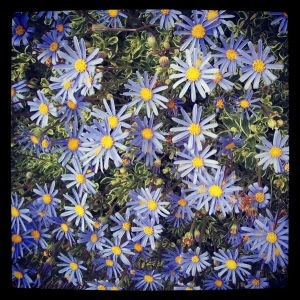Ficus benjamina
Far beyond the small office or house trees you often see, my Ficus benjamina are large, dense trees that shade a large portion of my back garden. I don’t particularly like them — I find them a bit too pushy, but they do an excellent job of adding some green to the woodland garden that is our backyard and provide a good, dense, cooling shade in our hot summers.

Follow DouglasWelch in Instagram
Ficus benjamina, commonly known as the weeping fig, Benjamin’s fig, or ficus tree and often sold in stores as just ficus, is a species of flowering plant in the familyMoraceae, native to south and southeast Asia and Australia. It is the official tree of Bangkok. It is a tree reaching 30 metres (98 ft) tall in natural conditions, with gracefully drooping branchlets and glossy leaves 6–13 cm (2–5 in), oval with an acuminate tip. In its native range, its small fruit are favored by some birds, such as theSuperb Fruit Dove, Wompoo Fruit Dove, Pink-spotted Fruit Dove, Ornate Fruit Dove, orange-bellied Fruit Dove, Torresian Imperial Pigeon, Purple-tailed Imperial Pigeon(Frith et al. 1976).
In tropical latitudes, the weeping fig makes a very large and stately tree for parks and other urban situations, such as wide roads. It is often cultivated for this purpose.
It is a very popular houseplant in temperate areas, due to its elegant growth and tolerance of poor growing conditions; it does best in bright, sunny conditions but will also tolerate considerable shade. It requires a moderate amount of watering in summer, and only enough to keep it from drying out in the winter. It does not need to be misted. The plant is sensitive to cold and should be protected from strong drafts. When grown indoors, it can grow too large for its situation, and may need drastic pruning or replacing. Ficus benjamina has been shown to effectively remove gaseous formaldehyde from indoor air.[2]
The fruit is edible, but the plant is not usually grown for its fruit. The leaves are very sensitive to small changes in light. When it is turned around or re-located it reacts by dropping many of its leaves and replacing them with new leaves adapted to the new light intensity.
There are numerous cultivars available (e.g. ‘Danielle’, ‘Naomi’, ‘Exotica’, and ‘Golden King’). Some cultivars include different patterns of colouration on the leaves, ranging from light green to dark green, and various forms of white variegation.
In cultivation in the UK, this plant[3] and the variegated cultivar ‘Starlight’[4] have gained the Royal Horticultural Society‘s Award of Garden Merit.
The miniature cultivars, especially ‘Too Little’, are among the most popular plants for indoor bonsai. Full-sized, artificial versions are also commonly found in North America and Europe. — Wikipedia
More information on Ficus benjamina:
- Ficus benjamina on Wikipedia
- Ficus benjamina at Missouri Botanical Garden
- The Weeping Fig, Ficus benjamina- indoor and out at Dave’s Garden
- Acanthus
- Amaryllis
- Apricot (Prunus armeniaca)
- Aspen
- Azalea
- Banana
- Bonsai
- Bougainvillea
- Brugmansia
- Butterfly (Lepidoptera)
- California Flannelbush (Fremontodendron californicum)
- California Poppy (Eschscholzia californica)
- Calla Lily (Zantedeschia aethiopica)
- Campsis radicans
- Castor Bean (Ricinus)
- Caltapa
- Chives (Allium schoenoprasum)
- Clematis
- Camellia
- Currant (Ribes)
- Dahlia
- Datura
- Japanese Cherry (Prunus serrulata)
- Daffodil (Narcissus)
- Dietes (Fortnight Lily)
- Dudleya
- Echinacea
- Ecualyptus
- Freesia
- Fungi
- Gerbera Daisy
- Grape (Vitis vinifera)
- Helianthus (sunflower)
- Hibiscus (Malvaceae)
- Iris
- Jacaranda mimosifolia
- Joshua Tree (Yucca brevifolia)
- Kniphofia “Red Hot Poker”
- Lantana
- Lavender (Lavendula)
- Kousa Dogwood (Cornus kousa)
- Magnolia x soulangeana (Saucer Magnolia/Tulip Tree)
- Mandevilla
- Magnolia Grandiflora
- Marigold (Calendula officinalis)
- Matilija Poppy (Romneya)
- Morning Glory (Convolvulaceae)
- Nandina
- Oleander (Nerium)
- Orange
- Orchid from the Southern California Spring Garden Show 2013
- Oriental Poppy (Papaver orientale)
- Polygonatum (Solomon’s Seal)
- Paperwhites
- Pineapple (Ananas comosus)
- Primula (Primrose)
- Queen Anne’s Lace (Daucus carota)
- Rosa ‘Mikado’
- Rudbeckia
- Salvia
- Squirrel
- Star Jasmine (Trachelospermum jasminoides)
- Succulents
- California Sycamore (Platanus racemosa)
- Sweet Potato (Ipomoea batatas)
- Tomato
- Water Lily (Nymphaeaceae)
- Wisteria





